8.3 Infancy and Child Development
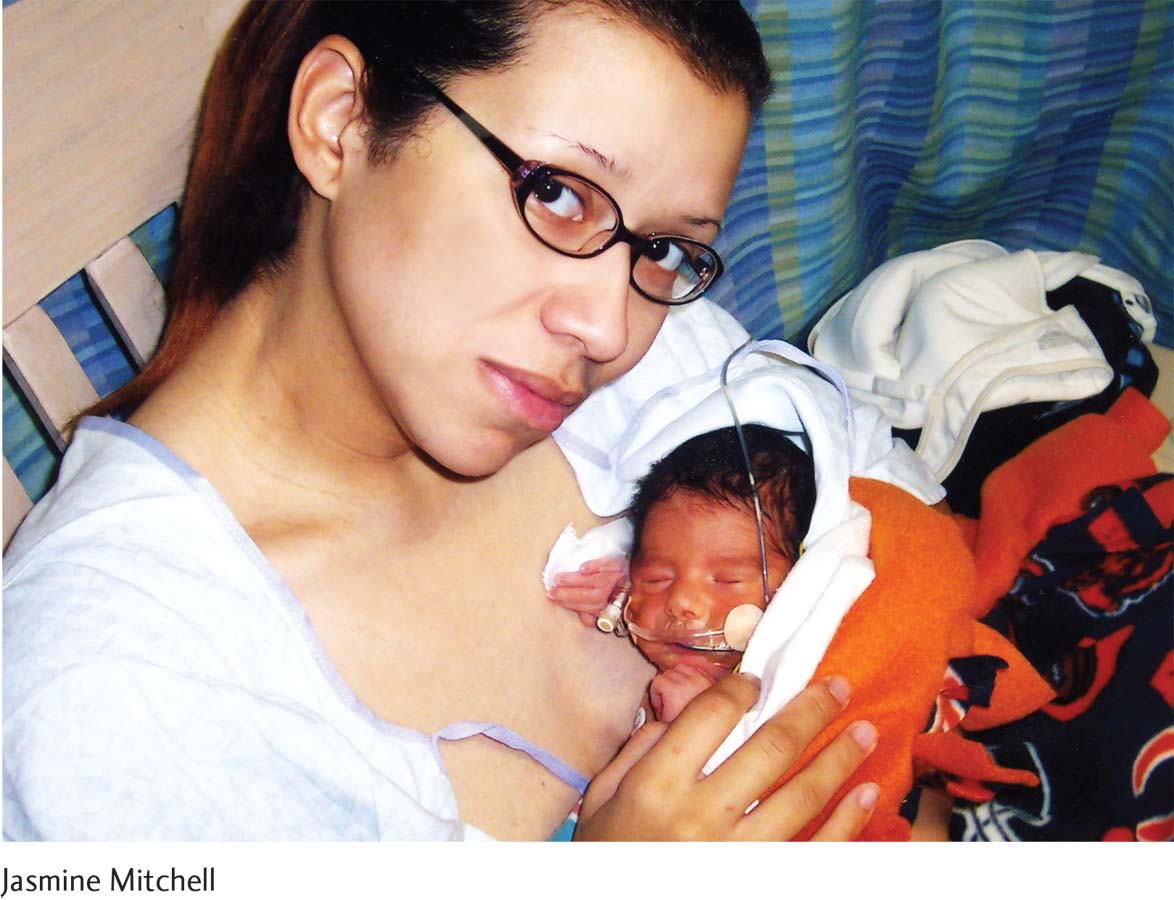
Jasmine “kangaroos” with her son Eddie in the neonatal intensive care unit. Kangarooing, or holding a premature baby to facilitate skin-
 26 AND PREGNANT The circumstances surrounding the birth of Jasmine’s second child were strikingly different from those of her first. When Eddie came into the world, Jasmine was a married, working woman with 10 more years of life experience; and a decade can make a world of difference in development. As Jasmine can testify, “The mental capacity is way different between a 16-
26 AND PREGNANT The circumstances surrounding the birth of Jasmine’s second child were strikingly different from those of her first. When Eddie came into the world, Jasmine was a married, working woman with 10 more years of life experience; and a decade can make a world of difference in development. As Jasmine can testify, “The mental capacity is way different between a 16-
Being pregnant with Eddie was nothing like the carefree experience of carrying Jocelyn. Jasmine noticed every ache and pain, and her nausea was so severe that she lost 20 pounds during the first few months. About midway into the pregnancy, doctors put her on strict bed rest in an effort to prevent a premature delivery, but Eddie still arrived 9 weeks early. In developed countries like the United States, the age of viability, or the earliest point at which a baby can survive outside of the mother’s womb, has dropped to 22 weeks gestational age (Lawn et al., 2011).
During the fetal period, the digestive, respiratory, and other organ systems become fully developed. For babies born early, those systems may not be fully prepared to function. Eddie needed a breathing tube, a feeding tube, and an incubator because he could not yet control his body temperature. For a week following his delivery, Jasmine could only make contact by sticking her hands through a hole in his incubator. When she finally did get to hold Eddie, his response was breathtaking. Not only did he stop fussing and whining, he reacted with measurable physiological changes. “His vital signs went up,” Jasmine says. “He breathed better on his own.” 
Newborn Growth and Development
LO 7 Summarize the physical changes that occur in infancy.
Newborn babies exhibit several reflexes, or unlearned patterns of behavior. Some are necessary for survival; others do not serve any obvious purpose. A few fade away in the first weeks and months of life, but many will resurface as voluntary movements as the infant grows and develops motor control (Thelen & Fisher, 1982). Let’s take a look at two of these reflexes.
318
ROOTING AND SUCKING REFLEXES What does a newborn do when you stroke her cheek? She opens her mouth and turns her head in the direction of your finger, apparently in search of a nipple. This rooting reflex typically disappears at 4 months, never to be seen again. The sucking reflex, evident when you touch her lips, also appears to be a feeding reflex. Sucking and swallowing abilities don’t fully mature until the gestational age of 33 to 36 weeks, so babies who are born before that time—
A newborn spends most of his time eating, sleeping, and crying. Sounds like a simple routine, but waking every 2 to 3 hours to feed a wailing baby can be very exhausting. Nevertheless, this stage soon gives way to a period of change that is far more interactive, and includes waving, clapping, walking, and dangerous furniture climbing. Infographic 8.2 details some of the sensory and motor milestones of infancy. Keep in mind that the listed ages are averages; significant variation does exist across infants. The general sequence and timing, however, are fairly universal.
INFOGRAPHIC 8.2
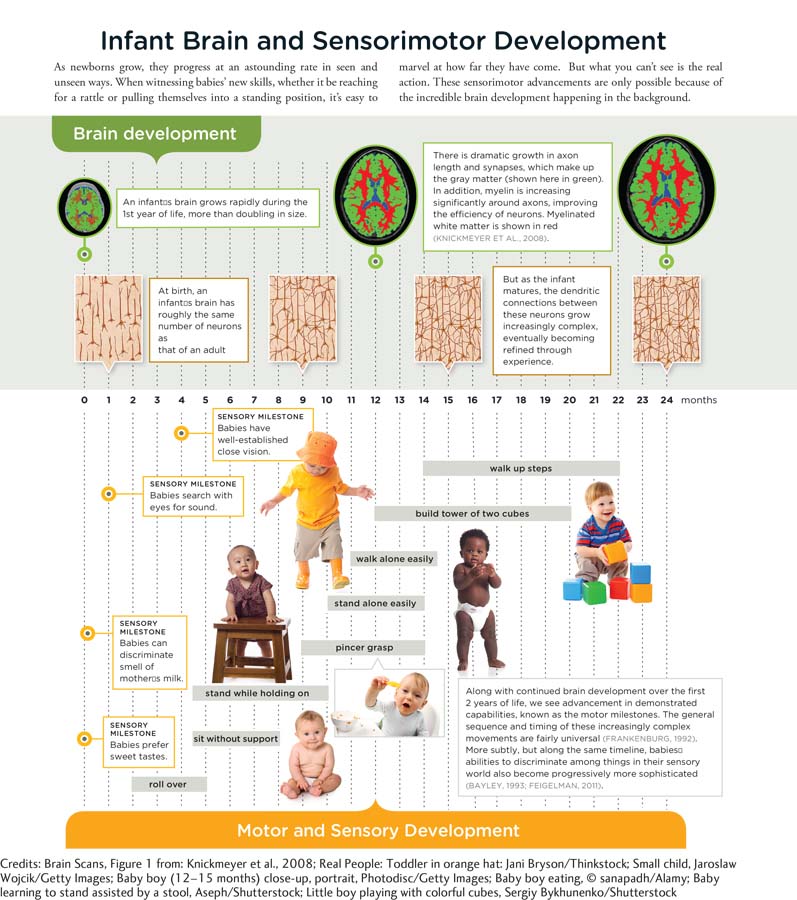
THE NEWBORN SENSES Babies come into the world equipped with keen sensory capabilities that seem to be designed for facilitating relationships. For example, infants prefer to look at human faces as opposed to geometric shapes (Salva, Farroni, Regolin, Vallortigara, & Johnson, 2011). Within hours of birth, they can discriminate their mother’s voice from those of other women, and they show a preference for her voice (DeCasper & Fifer, 1980). Research suggests babies come to recognize their mother’s voice while in the womb (Kisilevsky et al., 2003; Sai, 2005). Jocelyn came into the world crying but calmed down instantly when placed in Jasmine’s arms, as if she already knew the sound of her mother speaking and singing. Hearing is developed and functioning before a baby is born, but sounds are initially distorted. It takes some time for amniotic fluid to dry up completely before a baby can hear clearly (Hall, Smith, & Popelka, 2004).
Smell and taste are also well developed in newborn infants. These tiny babies can distinguish the smell of their own mothers’ breast milk from that of other women within days of birth (Nishitani et al., 2009). Babies prefer sweet tastes, react strongly to sour tastes, and notice certain changes to their mothers’ diets because those tastes are present in breast milk. If a mother eats something very sweet, for instance, the infant tends to breastfeed longer.
The sense of touch is evident before birth; as early as 2 months after conception, for example, a fetus will show the rooting reflex. It was once believed that newborns were incapable of experiencing pain. But research suggests otherwise. Newborns respond to pain with reactions similar to those of older infants, children, and adults (Gradin & Eriksson, 2011; Urso, 2007).
CONNECTIONS
In Chapter 3, we reported that cones are specialized neurons called photoreceptors, which absorb light energy and turn it into chemical and electrical signals for the brain to process. Cones enable us to see colors and details. Newborns have blurry eyesight in part because their cones have not fully developed.
Sight is the weakest sense in newborns, who have difficulty seeing things that are not in their immediate vicinity. The optimal distance for a newborn to see an object is approximately 8–
319
320
CONNECTIONS
In Chapter 2, we described the structure of a typical neuron, which includes an axon projecting from the cell body. Many axons are surrounded by a myelin sheath, which is a fatty substance that insulates the axon. This insulation allows for faster communication within and between neurons. Here we see how this impacts motor development.
THE GROWING BRAIN The speed of brain development in the womb and immediately after birth is astounding. There are times in fetal development when the brain is producing some 250,000 new neurons per minute! The creation of new neurons is mostly complete by the end of the 5th month of fetal development (Kolb & Gibb, 2011). At the time of birth, a baby’s brain has approximately 100 billion neurons (Toga, Thompson, & Sowell, 2006)—roughly the same number as that of an adult. Meanwhile, axons are growing longer, and more neurons—
SYNAPTIC PRUNING Neurons rapidly sprout new connections to each other, a dramatic phase of synaptic growth that is influenced by the infant’s experiences and stimulation from the environment. The increase in connections is not uniform throughout the brain. Between the ages of 3 and 6, for example, the greatest increase in neural connections occurs in the frontal lobes, the area of the brain involved in planning and attention (Thompson et al., 2000; Toga et al., 2006). As more links are established, more associations can be made between different stimuli, and between behavior and consequences. A young person needs to learn quickly, and this process makes it possible.
However, the extraordinary growth in synaptic connections does not last forever, as their number decreases by 40% to 50% by the time a child reaches puberty (Thompson et al., 2000; Webb, Monk, & Nelson, 2001). In a process known as synaptic pruning, unused synaptic connections are downsized or eliminated (Chechik, Meilijson, & Ruppin, 1998).
Synaptic pruning and other aspects of brain development are strongly influenced by experiences and input from the outside world. In the 1960s and 1970s, Mark Rosenzweig and his colleagues at the University of California, Berkeley, demonstrated how much environment can influence the development of nonhuman animal brains (Kolb & Whishaw, 1998). They found that rats placed in stimulating environments (furnished with opportunities for exploration and social interaction) experience greater increases in brain weight and synaptic connections than those put in nonstimulating environments (Barredo & Deeg, 2009, February 24; Kolb & Whishaw, 1998; Rosenzweig, 1984). Environmental stimulation (or lack thereof) also appears to influence the brain development of infants and children. Some research suggests that orphanage-

A kindergarten teacher leads students through dance movements (left) in what appears to be an enriched environment. Opportunities for physical exercise, social interaction, and other types of stimulating activity characterize enriched environments, which promote positive changes in the brain (van Praag, Kempermann, & Gage, 2000). Fewer signs of enrichment appear in the photo on the right, which shows another teacher with her class of preschoolers in a sparse room without books or even furniture.
The Language Explosion
321
CONNECTIONS
In Chapter 7, we introduced the basic elements of language, such as phonemes, morphemes, and semantics, and explored how language relates to thought. In this chapter, we discuss how language develops.
The brain development that occurs during childhood and the cognitive changes associated with it are remarkable. Consider the fact that babies come into the world incapable of using language, yet by the age of 6, most have amassed a vocabulary of about 13,000 words (Pinker, 1994). Let’s take a look at some of the theories that attempt to explain the language explosion.
LO 8 Describe the theories explaining language acquisition.
CONNECTIONS
Chapter 5 presented the principles of learning. Here, we see how operant conditioning, through reinforcement and punishment, and observational learning, through modeling, can be used to understand how language is acquired.
BEHAVIORISM AND LANGUAGE Behaviorists propose that all behavior—
LANGUAGE ACQUISITION DEVICE But the behaviorist theory may not explain all the complexities of language acquisition. If a young child tries to imitate a particular sentence structure, such as “I am going to the kitchen,” he might instead say something grammatically incorrect, “I go kitchen.” Children are not directly taught the structure of grammar, because its rules are too difficult for their developing brains to understand. Linguist Noam Chomsky (1959) suggested humans have a language acquisition device (LAD) that provides an innate mechanism for learning language. With the LAD, children compare the language they hear in their environment to a framework already hardwired in their brains. The fact that children all over the world seem to learn language in a fixed sequence, and during approximately the same sensitive period, is evidence that this innate language capacity exists.
Synonyms
infant-
INFANT-
LANGUAGE IN THE ENVIRONMENT It’s not only the type of voice that matters but also the amount of talking. Infants may not be the best conversation partners, but they benefit from a lot of chatter. It turns out that the amount of language spoken in the home correlates with socioeconomic status. Children from high-
322
LO 9 Outline the universal sequence of language development.
cooing Production of vowel-
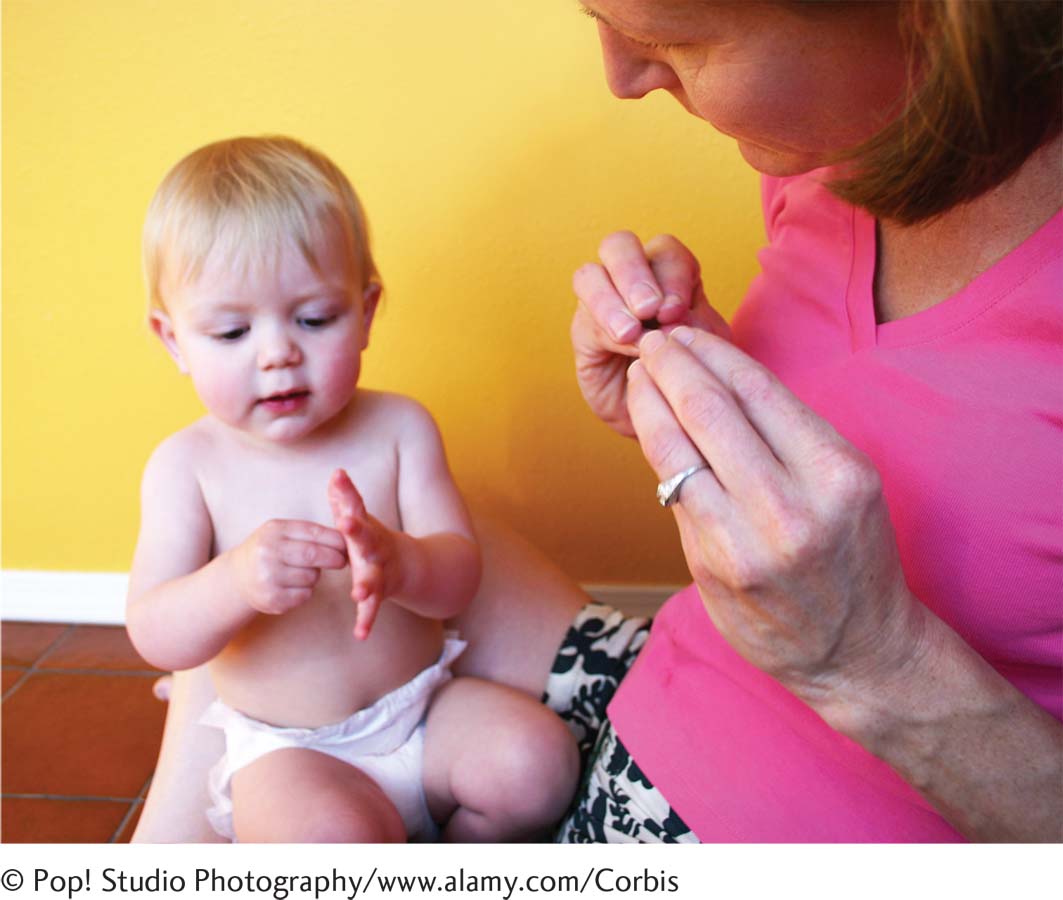
A baby and a caregiver communicate with sign language. Introducing sign to children as young as 6 months may help them communicate before they use verbal speech (Doherty-
THE SEQUENCE OF ACQUISITION Coo. Babble. Talk. No matter what language infants speak, or who raises them, you can almost be certain they will follow the universal sequence of language development (Chomsky, 2000). At the age of 2 to 3 months, infants typically start to produce vowel-
babbling The combining of consonants with vowels typically displayed at the age of 4 to 6 months.
When infants reach the age of 4 to 6 months, they begin to combine consonants and vowels in the babbling stage. These sounds are meaningless, but babbling can resemble real language (“ma, ma, ma, ma, ma” Did you say . . . mama?). Jasmine distinctly remembers Jocelyn as a tiny infant repeating “da, da, da, da,” as if she were saying “Dadda” over and over. Amused by the irony of the situation (Jasmine was a single mother), she would put her face close to Jocelyn’s and repeatedly say, “ma, ma, ma, ma.” Nonhearing infants also go through this babbling stage, but they move their hands instead of babbling aloud (Petitto & Marentette, 1991). For both hearing and deaf infants, the babbling stage becomes an important foundation for speech production; when infants babble, they are on their way to their first words.
When do real words begin? At around 12 months, infants typically begin to utter their magical first words. Often, these are nouns used to convey an entire message, or holophrase. Perhaps you have heard an infant say something emphatically, such as “JUICE!” or “UP!” What she might be trying to say is “I am thirsty, could I please have some juice?” or “I want you to pick me up.”
telegraphic speech Two-
At about 18 months, infants start to use two-

During the second year of life, a child’s vocabulary increases dramatically.
There are two important components of normal language acquisition: (1) physical development, particularly in the language-
323
THINK again
Genie the “Feral Child”
 In 1970 a social worker in Arcadia, California, discovered a most horrifying case of child neglect and abuse. “Genie,” as researchers came to call her, was 13 at the time her situation came to the attention of the authorities, though she barely looked 7. Feeble and emaciated, the child could not even stand up straight. Genie was not capable of chewing food or using a toilet. She could not articulate a single word (Curtiss, Fromkin, Krashen, Rigler, & Rigler, 1974; PBS, 1997, March 4).
In 1970 a social worker in Arcadia, California, discovered a most horrifying case of child neglect and abuse. “Genie,” as researchers came to call her, was 13 at the time her situation came to the attention of the authorities, though she barely looked 7. Feeble and emaciated, the child could not even stand up straight. Genie was not capable of chewing food or using a toilet. She could not articulate a single word (Curtiss, Fromkin, Krashen, Rigler, & Rigler, 1974; PBS, 1997, March 4).
Between the ages of 20 months and 13 years, Genie had been locked away in a dark room, strapped to a potty chair or confined in a cagelike crib. Her father beat her when she made any type of noise. There, Genie stayed for 12 years, alone in silence, deprived of physical activity, sensory stimulation, and affection (Curtiss et al., 1974).
When discovered and brought to a hospital at age 13, Genie would not utter a sound (Curtiss et al., 1974). She did seem to understand simple words, but that was about it for her language comprehension. Researchers tried to build Genie’s vocabulary, teaching her basic principles of syntax, and she made considerable gains, eventually speaking meaningful sentences. But some aspects of language, such as the ability to use the passive tense (“The carrot was given to the rabbit”) or words such as “what” and “which” continued to mystify her (Goldin-
AT AGE 13, GENIE COULD NOT EVEN SPEAK
We should note that Genie’s story does end with a glimmer of hope. Genie is reported to be “happy,” living in a group home for adults with intellectual disabilities (James, 2008, May 7). 
Piaget and Cognitive Development

Developmental psychologist Jean Piaget (center) works with students in a New York City classroom. Piaget’s research focused on school-
LO 10 Summarize the key elements of Piaget’s and Vygotsky’s theories of cognitive development.
Language is just one domain of cognitive development. How do other processes like memory and problem solving evolve through childhood? As noted earlier, psychologists do not always agree on whether development is continuous or occurs in steps. Swiss biologist and developmental psychologist Jean Piaget (pyä-'zhā; 1896–
schema A collection of ideas that represents a basic unit of understanding.
One of the basic units of cognition, according to Piaget (1936/1952), is the schema, a collection of ideas or notions representing a basic unit of understanding. Young children form schemas based on functional relationships. The schema “toy,” for example, might include any object that can be played with (such as dolls, trucks, and balls). As children mature, so do their schemas, which begin to organize and structure their thinking around more abstract categories, such as “love” (romantic love, love for one’s country, and so on). As they grow, children expand their schemas in response to interactions with the environment and other life experiences.
assimilation Using existing information and ideas to understand new knowledge and experiences.
accommodation A restructuring of old ideas to make a place for new information.
324
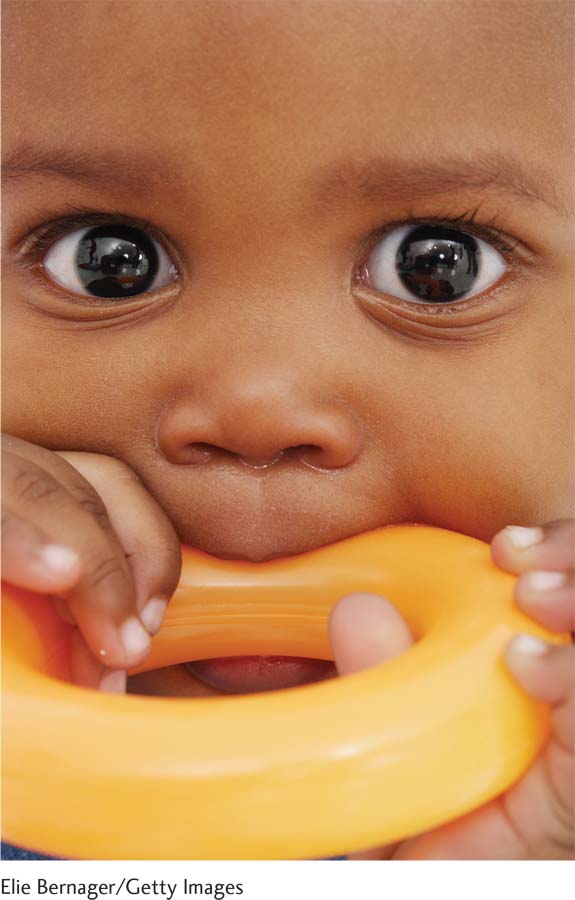
Babies are notorious for putting just about everything, including toys, shoes, and sand, in their mouths. Mouthing is one of the main ways babies experience their worlds, and it is an important aspect of cognitive development. It also provides exposure to viruses and other environmental pathogens, which helps prepare the developing immune system to fight infections (Fessler & Abrams, 2004).
Piaget (1936/1952) believed humans are biologically driven to advance intellectually, partly as a result of an innate need to maintain cognitive equilibrium, or a feeling of cognitive balance. Suppose a kindergartener’s schema of airplane pilots includes only men, but then he sees a female pilot on television. This experience shakes up his notion of who can be a pilot, causing an uncomfortable sense of disequilibrium that motivates him to restore cognitive balance. There are two ways he might accomplish this. He could use assimilation, an attempt to understand new information using his already existing knowledge base, or schema. For example, the young boy might think about the female bus drivers he has seen and connect that to the female pilot idea (Women drive buses, so maybe they can fly planes too). However, if the new information is so disconcerting that it cannot be assimilated, he might use accommodation, a restructuring of old notions to make a place for new information. With accommodation, we remodel old schemas or create new ones. If the child had never seen a female driving anything other than a car, he might become confused at the sight of a female pilot. To eliminate that confusion, he could create a new schema (Women drive all sorts of vehicles). This is how we make great strides in cognitive growth. We assimilate information to fit new experiences into our old ways of thinking, and we accommodate our old way of thinking to understand new information.
Piaget (1936/1952) also proposed that cognitive development occurs in four periods or stages, and these stages have distinct beginnings and endings (Infographic 8.3).
INFOGRAPHIC 8.3
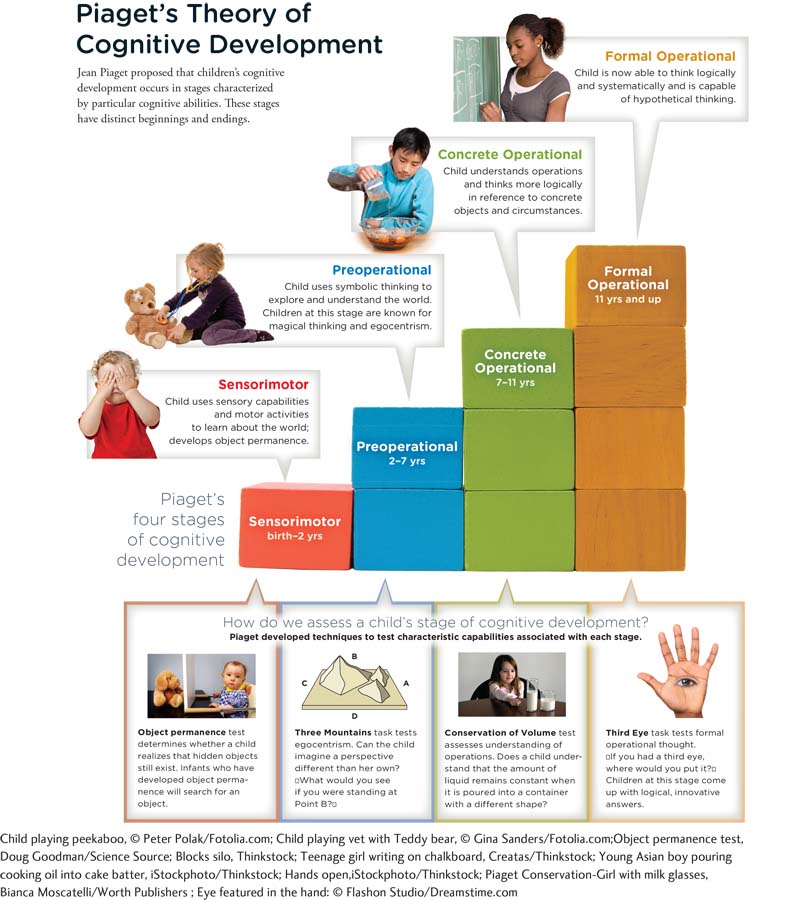
sensorimotor stage Piaget’s stage of cognitive development during which infants use their sensory capabilities and motor skills to learn about the surrounding world.
SENSORIMOTOR STAGE From birth to about 2 years old is the sensorimotor stage. Infants use their sensory abilities and motor activities (such as reaching, crawling, and handling things) to learn about the surrounding world, exploring objects with their mouths, fingers, and toes. It’s a nerve-
object permanence A milestone of the sensorimotor stage of cognitive development; an infant’s realization that objects and people still exist even when out of sight or touch.
One significant milestone of the sensorimotor stage is object permanence, or an infant’s realization that objects and people still exist when they are out of sight or touch. Have you ever watched a young infant play peekaboo? Her surprise when your face reappears suggests that she forgot you were there when your face was hidden. Jasmine tried to play peekaboo with Eddie when he was a baby, but he had a mixed reaction to the game, crying when she hid her face behind a blanket and laughing as soon as she pulled it away. Eddie’s fear of his mother’s disappearance and surprise at her reappearance didn’t last; he learned about object permanence.
preoperational stage Piaget’s stage of cognitive development during which children can start to use language to explore and understand their worlds.
egocentrism Only able to imagine the world from one’s own perspective.
PREOPERATIONAL STAGE The next stage in cognitive development is the preoperational stage, which applies to children from 2 to 7 years old. During this time, children start using language to explore and understand their worlds (rather than relying primarily on sensory and motor activities). In this stage, children ask questions and use symbolic thinking. They may use words and images to refer to concepts. This is a time for pretending and magical thinking. Eddie, for example, likes to pretend he is Harry Potter. He drives Jasmine and Jocelyn crazy, racing around the house with a wand. Children in this stage are somewhat limited by their egocentrism. They can only imagine the world around them from their own perspective (see the Three Mountains task in Infographic 8.3).
conservation Refers to the unchanging properties of volume, mass, or amount in relation to appearance.
According to Piaget (1936/1952), children in this stage have not yet mastered operations (hence, the name preoperational stage), which are the logical reasoning processes that older children and adults use to understand the world. For example, these children have a difficult time understanding the reversibility of some actions or events. They may have trouble comprehending that vanilla ice cream can be refrozen after it melts, but not turned back into sugar, milk, and vanilla. This difficulty with operations is also apparent in errors involving conservation, which refers to the unchanging properties of volume, mass, or amount in relation to appearance (Figure 8.4). For example, if you take two masses of clay of the same shape and size, and then roll only one of them out into a hotdog shape, a child in this stage may think that the longer-
325
326

Children in the preoperational stage don’t realize that properties like volume and mass stay constant when items are only rearranged or reshaped. Tasks like those outlined here are used to test children’s understanding of the concept of conservation.
concrete operational stage Piaget’s stage of cognitive development during which children begin to think more logically, but mainly in reference to concrete objects and circumstances.
CONCRETE OPERATIONAL STAGE Around age 7, children enter what Piaget called the concrete operational stage. They begin to think more logically, but mainly in reference to concrete objects and circumstances: things that can be seen or touched, or are well defined by strict rules. Children in this stage tend to be less egocentric and can understand the concept of conservation. However, they still have trouble with abstract concepts. Around age 8 or 9, Jocelyn tended to take everything literally. Once she asked to go outside when it was pouring rain, and Jasmine replied, “Are you crazy? It’s raining cats and dogs!” Jocelyn became distressed and cried, “The poor little kitties are gonna get hurt when they fall from the sky!” Children in this stage also have trouble thinking hypothetically. A 7-
formal operational stage Piaget’s stage of cognitive development during which children begin to think more logically and systematically.
FORMAL OPERATIONAL STAGE Children enter the formal operational stage at age 11; they begin to think more logically and systematically. They can solve problems such as those in the Third Eye task in Infographic 8.3. This activity asks a child where she would put a third eye, and why. (I’d put it in the back of my head so that I could see what is going on behind my back.) These types of capabilities do not necessarily develop overnight, and logical abilities are likely to advance in relation to interests and to skills developed in a work setting. Piaget suggested that not everyone reaches this stage of formal operations. But to succeed in most colleges, this type of logical thinking is essential; students need to think critically and use abstract concepts to solve problems.
327
THE CRITICS Critics of Piaget suggest that although cognitive development might occur in stages with distinct characteristics, the transitions from one stage to the next are likely to be gradual, and do not necessarily represent a complete leap from one type of thinking to the next. Some believe Piaget’s theory underestimates children’s cognitive abilities. For example, some researchers have found that object permanence occurs sooner than suggested by Piaget (Baillargeon, Spelke, & Wasserman, 1985). Others question Piaget’s assertion that the formal operational stage is reached by 11 to 12 years of age, and that no further delineations can be made between the cognitive abilities of adolescents and adults of various ages. One solution is to account for cognitive changes occurring in adulthood by considering stages beyond Piaget’s original formulation.
Vygotsky and Cognitive Development
One other major criticism of Piaget’s work is that it does not take into consideration the social interactions that influence the developing child. Russian psychologist Lev Vygotsky (vī-'gät-
How might social interactions impact a child’s cognitive development? Children are like apprentices in relation to others who are more capable and experienced (Zaretskii, 2009). Those children who receive help from older children and adults progress more quickly in their cognitive abilities. For example, when parents help their children solve puzzles by providing support for them to succeed on their own, the children show advancement in goal-
scaffolding Pushing children to go just beyond what they are competent and comfortable doing, while providing help in a decreasing manner.
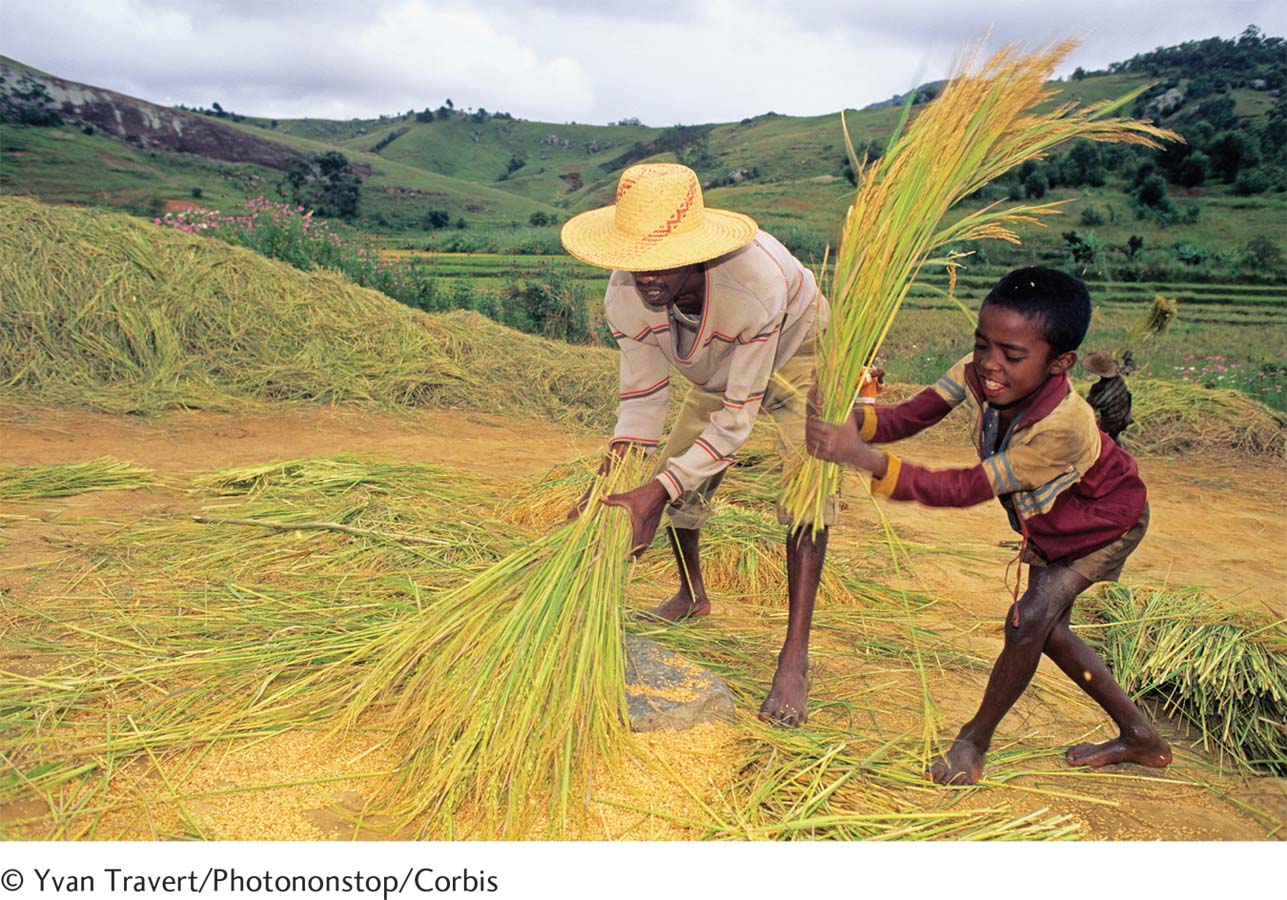
A man and a boy work together threshing rice in the fields of Madagascar. What this child learns and how his cognitive development unfolds are shaped by the circumstances of his environment. Children reared in agricultural societies may acquire different cognitive skill sets than those raised in urban, industrialized settings.
One way we can support children’s cognitive development is through scaffolding: pushing them to go just beyond what they are competent and comfortable doing, but also providing help in a decreasing manner. A parent or caregiver provides support when necessary, but allows a child to solve problems independently: “Successful scaffolding is like a wave, rising to offer help when needed and receding as the child regains control of the task” (Hammond et al., 2012, p. 275).
Vygotsky also emphasized that learning always occurs within the context of a child’s culture. Children across the world have different sets of expected learning outcomes, from raising sheep to weaving blankets to playing basketball. We need to keep these cross-
328
 SOME THINGS NEVER CHANGE Jocelyn and Eddie have very different personalities, and their unique characteristics began to surface early in their development. Jocelyn has always been easygoing and mild-
SOME THINGS NEVER CHANGE Jocelyn and Eddie have very different personalities, and their unique characteristics began to surface early in their development. Jocelyn has always been easygoing and mild-
Jocelyn was a social butterfly from the start. As an infant, she would perk up on hearing a voice or spotting a person’s face, and she began to talk at an early age. Baby Eddie was not such a “people person.” He was more entranced by the bright colors and shapes he saw on TV programs for infants and toddlers. He also began to talk and walk considerably later than Jocelyn. But as his pediatrician said, these developmental discrepancies probably had a lot to do with gender (boys tend to lag behind girls in language and motor skills) and the fact that Eddie was born 2½ months early.
Many of Jocelyn’s and Eddie’s personality traits remained stable through toddlerhood. Both children started day care around the age of 2, but their adjustments to this change in routine were starkly different. Jocelyn, always very social, never cried after being dropped off. Eddie, the more introverted sibling, cried every day for 3 or 4 months. Why he had such a hard time saying goodbye is unclear, but there are probably many reasons. Perhaps he preferred the quiet solitude of home to the bustling environment of the childcare center, or maybe it had something to do with his parents’ marital problems at the time. Eddie was experiencing separation anxiety, and we usually see this peak at approximately 13 months (Hertenstein & McCullough, 2005). Now that Eddie has spent years in daycare and school, he has no problem being away from home. Any delays in language or motor development he experienced as a result of prematurity have long since vanished. “Now,” says Jasmine, “he is 5 going on 15, mentally and physically.” 
Temperament and Attachment
Until now, we have mostly discussed physical and cognitive development, but recall we are also interested in socioemotional development. When thinking about Jocelyn and Eddie, it is important to consider their relationships, emotional processes, and temperaments.
temperament Characteristic differences in behavioral patterns and emotional reactions that are evident from birth.
TEMPERAMENT From birth, infants display characteristic differences in their behavioral patterns and emotional reactions, that is, their temperament. Some babies and toddlers can be categorized as having an exuberant temperament, showing an overall positive attitude and sociability (Degnan et al., 2011). “High-
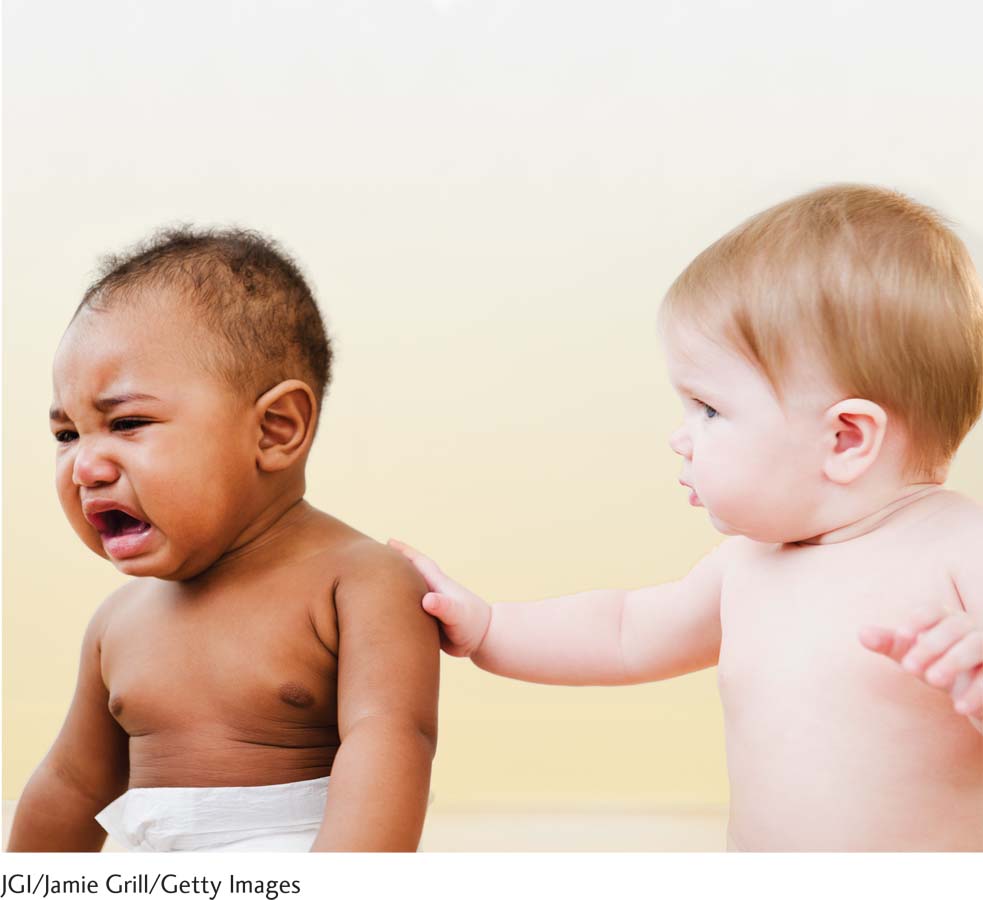
Most babies can be classified according to one of three fundamental temperaments: about 40% are “easy,” meaning they are generally content and follow predictable schedules; approximately 10% are “difficult,” or hard to please and irregular in their schedules; and another 15% are “slow to warm up,” meaning they struggle with change but eventually adjust. The remaining 35% do not fall into any one category.
These different characteristics seem to be innate, as they are evident from birth and consistent in the infants’ daily lives. There is also evidence that some of these characteristics remain fairly stable throughout life (Kagan & Snidman, 1991). However, the environment can influence temperament (Caspi, Roberts, & Shiner, 2005). Factors such as maternal education, neighborhood, and paternal occupation through adolescence can predict characteristics of adult temperament, such as persistence, shyness, and impulsiveness (Congdon et al., 2012).
329
EASY, DIFFICULT, OR SLOW TO WARM UP Researchers have found that the majority of infants can be classified as having one of three fundamental temperaments (Thomas & Chess, 1986). Around 40% are considered “easy” babies; they are easy to care for because they follow regular eating and sleeping schedules. These happy babies can be soothed when upset and don’t appear to get rattled by transitions or changes in their environments. Jasmine would put Jocelyn in this category. Baby Jocelyn’s crying was usually for an obvious reason, and she settled down when the problem was resolved.
“Difficult” babies (around 10%) are more challenging because they don’t seem to have a set schedule for eating and sleeping. And they don’t deal well with transitions or changes in the environment. Difficult babies are often irritable and unhappy, and compared to easy babies, they are far less responsive to the soothing attempts of caregivers. They also tend to be very active, kicking their legs on the changing table and wiggling like mad when you try to put on their clothes.
“Slow to warm up” babies (around 15%) are not as irritable (or active) as difficult babies, but they are not fond of change. Give them enough time, however, and they will adapt. Jasmine would place Eddie in this category. Eddie was not keen on the new day-
These categories of baby temperaments are useful, but we should remember that 35% of babies are considered hard to classify because they share the characteristics of more than one type.
Nature and Nurture
Destiny of the Difficult Baby
 Perhaps you are wondering about the long-
Perhaps you are wondering about the long-
Stright and colleagues (2008) studied over a thousand mothers and babies during the first 6 years of life. Baby temperament was assessed at 6 months, and the mothers and their children were observed interacting on six separate occasions, from 6 months old until the time they were first graders. The children’s first-
DO DIFFICULT BABIES BECOME OBNOXIOUS CHILDREN?
The researchers found that children with mothers demonstrating “higher-
330
As you can see, parents have the power to steer the development of their children in positive and negative directions. But what exactly makes a good parent? The adjectives or phrases that come to our minds are “patience,” “sensitivity,” “acceptance,” “strength,” and “unconditional love.” It also helps to be soft, warm, and snuggly—
CONNECTIONS
In Chapter 1, we discussed research ethics and the importance of ensuring the ethical treatment of research participants (human and nonhuman animal). Psychologists must do no harm and safeguard the welfare of participants. This would not have been possible if the Harlows had taken human newborns from their parents to study the importance of physical contact. Many even question the ethics of their use of newborn monkeys in this manner.
THE HARLOWS AND THEIR MONKEYS Research suggests that physical touch is a very important part of infant development. Among the first to explore this topic in an experimental situation were Harry Harlow, Margaret Harlow, and their colleagues at the University of Wisconsin (Harlow, Harlow, & Suomi, 1971). The researchers were initially interested in learning how physical contact affects the development of loving relationships between infants and mothers. But they realized this would be difficult to study with human infants; instead, they turned to newborn macaque monkeys (Harlow, 1958).
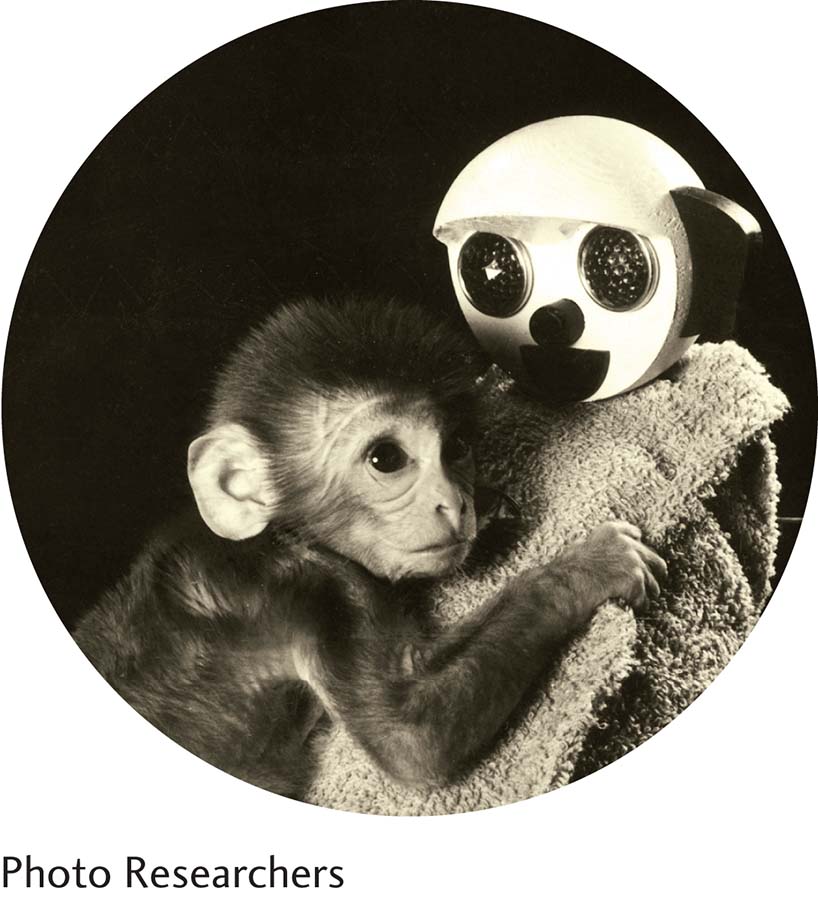
A baby monkey in a laboratory experiment clings to a furry mother surrogate. Research by Harry and Margaret Harlow and colleagues at the University of Wisconsin showed that physical comfort is important for the socioemotional development of these animals. When given the choice between a wire mesh “mother” that provided milk and a cloth-
Here’s how the experiment worked: Infant monkeys were put in cages alone, each with two artificial “surrogate” mothers. One surrogate was outfitted with a soft cloth and heated with a bulb. The other surrogate mother was designed to be lacking in “contact comfort,” as she was made of wire mesh and not covered in cloth. Both of these surrogates could be set up to feed the infants. In one study, half the infant monkeys received their milk from the cloth surrogates and the other half got their milk from the wire surrogates. The great majority of the infant monkeys spent most of their time clinging to or in contact with the cloth mother, even if she was not the mother providing the milk. The baby monkeys spent 15 to 18 hours a day physically close to the cloth mother, and only 1 to 2 hours touching the wire mother.
Harlow and colleagues also created situations in which they purposefully scared the infants with a moving toy bear, and found that the great majority of the infant monkeys (around 80%) ran to the cloth mother, regardless of whether she was a source of milk. In times of fear and uncertainty, these infant monkeys found more comfort in the soft and furry mothers. Through their experiments, Harlow and his colleagues showed how important physical contact is for these living creatures (Harlow, 1958; Harlow & Zimmerman, 1959).
attachment The degree to which an infant feels an emotional connection with primary caregivers.
ATTACHMENT Physical contact plays an important role in attachment, or the degree to which an infant feels an emotional connection with primary caregivers. Using a design called the Strange Situation, Mary Ainsworth (1913–
331
Secure attachment: Around 65% of the children were upset when their mothers left the room, but were easily soothed upon her return, quickly returning to play. These children seemed confident that their needs would be met and felt safe exploring their environment, using the caregiver as a “secure base.”
Avoidant attachment: Approximately 20% of the children displayed no distress when their mothers left, and they did not show any signs of wanting to interact with their mothers when they returned, seemingly happy to play in the room without looking at their mothers or the stranger. They didn’t seem to mind when their mothers left, or fuss when they returned.
Ambivalent: Children in this group (around 10%) were quite upset and very focused on their mothers, showing signs of wanting to be held, but unable to be soothed by their mothers. These children were angry (often pushing away their mothers) and not interested in returning to play.
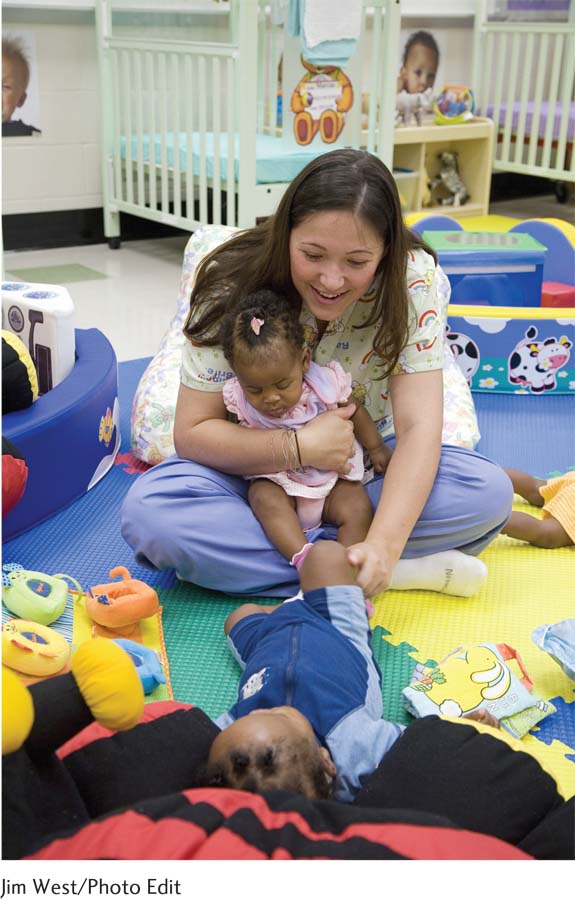
A childcare worker plays with toddlers at Moore Community Center’s Early Head Start program in Biloxi, Mississippi. Children are more willing to explore their environments when they have caregivers who consistently meet their needs and provide a secure base.
Ideally, parents and caregivers provide a secure base for infants, and are ready to help regulate emotions (soothe or calm) or meet other needs. This makes infants feel comfortable exploring their environments. Ainsworth and colleagues (1978) suggested that development, both physical and psychological, is greatly influenced by the quality of an infant’s attachment to caregivers. But much of the early research in this area focused on infants’ attachment to their mothers. Subsequent research suggests that we should examine infants’ attachment to multiple individuals (mother, father, caregivers at day care, and close relatives), as well as cross-
Critics of the Strange Situation method suggest it creates an artificial environment and does not provide good measures of how infant-
Attachments are formed early in childhood, but they have implications for a lifetime: “Experiences in early close relationships create internal working models that then influence cognition, affect, and behavior in relationships that involve later attachment figures” (Simpson & Rholes, 2010, p. 174). People who experienced ambivalent attachment as infants have been described as exhibiting an “insatiability for closeness” in their adult relationships. Those who had secure attachments are more likely to expect that they are lovable and that others are capable of love. They are aware that nobody is perfect, and this attitude allows for intimacy in relationships (Cassidy, 2001). Infant attachment may even have long-
Erikson’s Psychosocial Stages
LO 11 Describe how Erikson’s theory explains psychosocial development through puberty.
One useful way to understand socioemotional development is to consider its progression through stages. According to Erik Erikson (1902–

show what you know
332
Question 1
1. The _________ reflex occurs when you stroke a baby’s cheek; she opens her mouth and turns her head toward your hand. The _________ reflex occurs when you touch the baby’s lips; this reflex helps with feeding.
rooting; sucking
Question 2
2. Your instructor describes how he is teaching his infant to learn new words by showing her flashcards with images. Every time the infant uses the right word to identify the image, he gives her a big smile. When she uses an incorrect word, he frowns. Your instructor is using which of the following to guide his approach:
theories of behaviorism
Chomsky’s language acquisition device
infant-
directed speech telegraphic speech
a. theories of behaviorism
Question 3
3. Piaget suggested that when we try to understand new information and experiences by incorporating them into our existing knowledge and ideas, we are using:
the rooting reflex.
schemas.
accommodation.
assimilation.
d. assimilation.
Question 4
4. Vygotsky recommended supporting children’s cognitive development by _________, pushing them a little harder than normal while gradually reducing the amount of help you give them.
scaffolding
Question 5
5. Erikson proposed that socioemotional development comprises eight psychosocial stages, and these stages include:
scaffolding.
physical maturation.
developmental tasks or emotional crises.
conservation.
c. developmental tasks or emotional crises.
Question 6
6. What can new parents expect regarding the sequence of their child’s language development, and how might they help encourage it?
There is a universal sequence of language development. At around 2–